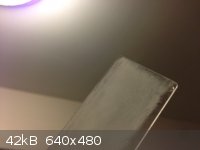hyfalcon
International Hazard
    
Posts: 1003
Registered: 29-3-2012
Member Is Offline
Mood: No Mood
|
|
Etching glazzed porcelain?
I need a way to etch the glaze finish from a porcelain spot plate. Anyone have any idea the best way to accomplish this? Here is the plate I need to
etch.
http://www.capitolscientific.com/CoorsTek-60427-12-Well-Porc...
|
|
|
sonogashira
National Hazard
   
Posts: 555
Registered: 10-9-2006
Member Is Offline
Mood: No Mood
|
|
Dilute hydrofluoric acid (ca. 9.5%) seems to be sold commercially for etching porcelain. Also in gel-form! http://www.amazon.com/Porcelain-Etchant-Gel-Veneers-Ceramic/...
[Edited on 17-9-2013 by sonogashira]
|
|
|
hyfalcon
International Hazard
    
Posts: 1003
Registered: 29-3-2012
Member Is Offline
Mood: No Mood
|
|
Thank you. I was hoping to avoid that chemical but everything is pointing me in that direction.
Would just using dilute HF in the cavity on the spot plate do what I'm needing to do? I just need the glaze gone and not the porcelain underneath.
[Edited on 17-9-2013 by hyfalcon]
|
|
|
papaya
National Hazard
   
Posts: 615
Registered: 4-4-2013
Member Is Offline
Mood: reactive
|
|
What about NaOH melt ?
|
|
|
hyfalcon
International Hazard
    
Posts: 1003
Registered: 29-3-2012
Member Is Offline
Mood: No Mood
|
|
Getting that whole thing up to that temp and keeping it there while melted isn't my idea of a fun date either.
|
|
|
Bot0nist
International Hazard
    
Posts: 1559
Registered: 15-2-2011
Location: Right behind you.
Member Is Offline
Mood: Streching my cotyledons.
|
|
The fired glaze is akin to glass. If you want to avoid using HF(aq), perhaps try a solution of ammonium bifloride. IIRC, it is a slightly safer way to
etch glass than HF(aq). Still, use caution.
U.T.F.S.E. and learn the joys of autodidacticism!
Don't judge each day only by the harvest you reap, but also by the seeds you sow.
|
|
|
Mailinmypocket
International Hazard
    
Posts: 1351
Registered: 12-5-2011
Member Is Offline
Mood: No Mood
|
|
Saturated ammonium bifluoride (~40%) works quite well. As the Botanist said though, be careful. A solution of this strength has etched glass within 1
minute in my experience. I have had good results by using saturated paper towel (w/ 40% aq ammonium bifluoride) on the areas to be etched. This etched
glass within minutes, for porcelain I am not sure but it must be close, experiment.
Here is a microscope slide that was exposed to ammonium bifluoride @40%. It was etched very quickly. On the glassy porcelain surface I would expect
the same.

[Edited on 18-9-2013 by Mailinmypocket]
|
|
|
hyfalcon
International Hazard
    
Posts: 1003
Registered: 29-3-2012
Member Is Offline
Mood: No Mood
|
|
I need to etch it down to the porcelain underneath. I'll give that one a go. What do you store the solution in? HDPE?
|
|
|
PHILOU Zrealone
International Hazard
    
Posts: 2893
Registered: 20-5-2002
Location: Brussel
Member Is Offline
Mood: Bis-diazo-dinitro-hydroquinonic
|
|
Maybe let some NaOH prills into it and allow air humidity to melt those at ambiant temperature...
Then it is only a matter of patience if you don't want to heat NaOH to speed up things...After a week or so...you should have porcelain etched.
I think that Na2CO3 fused can also be used as a glass etcher because of its basicity and it enters the composition of glass  so it dissolves a bit into the glass layer (like likes like) and after washing with
warm water some of the glazing must be etched so it dissolves a bit into the glass layer (like likes like) and after washing with
warm water some of the glazing must be etched 
PH Z (PHILOU Zrealone)
"Physic is all what never works; Chemistry is all what stinks and explodes!"-"Life that deadly disease, sexually transmitted."(W.Allen)
|
|
|
MrHomeScientist
International Hazard
    
Posts: 1806
Registered: 24-10-2010
Location: Flerovium
Member Is Offline
Mood: No Mood
|
|
Quote: Originally posted by PHILOU Zrealone  | Maybe let some NaOH prills into it and allow air humidity to melt those at ambiant temperature...
Then it is only a matter of patience if you don't want to heat NaOH to speed up things...After a week or so...you should have porcelain etched.
|
Just to clarify, when solid NaOH appears to liquify when left out exposed to air, it isn't actually melting. It is deliquescant - it ends up
dissolving in the water is absorbs from the air to form a very concentrated solution. This reacts quite differently than actual molten hydroxide,
which is melted at high temperature.
Your second point, though, is probably correct. Leaving such a saturated solution to sit for a long time would likely lead to some etching. I've never
thought of etching porcelain glaze though, so it'd be interesting to see what happens.
|
|
|